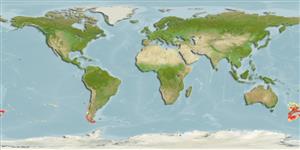Classification / Names
Common names from other countries
Main reference
Size / Weight / Age
Max length : 155 cm SL male/unsexed; (Ref. 58452); common length : 80.0 cm TL male/unsexed; (Ref. 1371); max. reported age: 30 years (Ref. 9072)
Length at first maturity
Lm 80.0, range 75 - 85 cm
Environment
Marine; benthopelagic; oceanodromous (Ref. 51243); depth range 28 - 1000 m (Ref. 58489)
Climate / Range
Subtropical, preferred 9°C (Ref. 107945); 33°S - 59°S, 165°E - 66°W (Ref. 58452)
Distribution
Circumglobal in the southern hemisphere (Ref. 7300). Two distinct groups. New Zealand population: Chatham Rise, Campbell Plateau and South Island northward to the East Cape. Patagonian population: Chiloé Island in the Pacific, southward around the southern tip of South America to the continental shelf to 59°S, and the slope north to 38°S in the Atlantic.
Countries | FAO areas | Ecosystems | Occurrences | Introductions
Short description
Dorsal
spines
(total): 1;
Dorsal
soft rays
(total): 48-57;
Anal
spines: 0;
Anal
soft rays: 40 - 46;
Vertebrae: 53 - 58. Body more slender than other hakes. Pectoral fins long and slender, stripe reaching anal fin in young individuals but not in fish over 50 cm in SL. Gill rakers short and thick with blunt tips. Color is steel gray on back grading to silvery white ventrally.
IUCN Red List Status (Ref. 115185)
Threat to humans
Harmless
Human uses
Fisheries: highly commercial
Tools
Special reports
Download XML
Internet sources
Estimates of some properties based on models
Phylogenetic diversity index
PD50 = 0.5000 many relatives (e.g. carps) 0.5 - 2.0 few relatives (e.g. lungfishes)
Trophic Level
4.5 ±0.79 se; Based on food items.
Resilience
Low, minimum population doubling time 4.5 - 14 years (K=0.07-0.19; tm=6-10; tmax=30)
Vulnerability
Moderate to high vulnerability (52 of 100)
Price category
